This article needs additional citations for verification .(November 2021) |
The following is a timeline of the History of Uppsala.
This article needs additional citations for verification .(November 2021) |
The following is a timeline of the History of Uppsala.
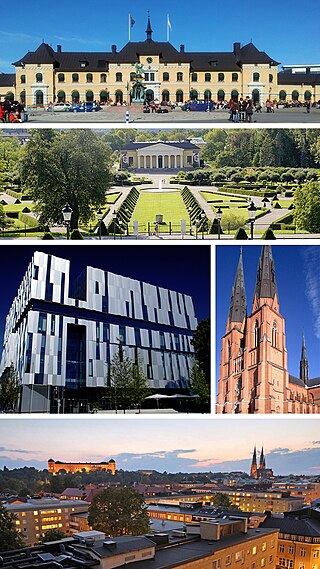
Uppsala is the county seat of Uppsala County and the fourth-largest city in Sweden, after Stockholm, Gothenburg, and Malmö. It had 177,074 inhabitants in 2019.

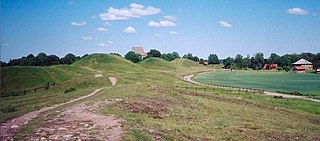
Gamla Uppsala is a parish and a village outside Uppsala in Sweden. It had 17,973 inhabitants in 2016.

The city of Uppsala is one of the oldest in Sweden. It has played a dominant role in the political, intellectual and historical development of the country. The two main institutions in the history of Uppsala are the Archdiocese which is located in the city, and Uppsala University, founded in the city in 1477. These have long been established on the western banks of the Fyris river with a bourgeois trading town on the other side of the river.


Carta marina et descriptio septemtrionalium terrarum is the first map of the Nordic countries to give details and place names, created by Swedish ecclesiastic Olaus Magnus and initially published in 1539. Only two earlier maps of the Nordic countries are known, those of Jacob Ziegler and Claudius Clavus.

Lars Roberg was a Swedish physician and natural science researcher. He served as a professor of anatomy and medicine at Uppsala University.

Baron Carl Hårleman was a Swedish architect.

Birger Nerman was a Swedish archaeologist, historian and philologist who specialized in the history and culture of Iron Age Sweden.
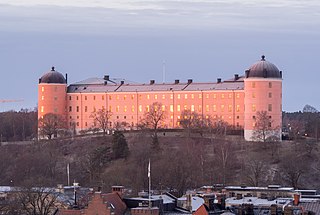
Uppsala Castle is a 16th-century royal castle in the city of Uppsala, Sweden. Throughout much of its early existence, the castle played a major role in the history of Sweden. Originally constructed in 1549, the castle has been heavily remodeled, expanded, and otherwise modified. Today the structure houses the official residence of the governor of Uppsala County, various businesses, and two museums.

Uppsala University Hospital in Uppsala, Sweden, is a teaching hospital for the Uppsala University Faculty of Medicine and the Nursing School. Uppsala University Hospital is owned and operated by the Uppsala County Council in cooperation with the university and serves, together with Enköping hospital in Enköping, as the primary hospitals for Uppsala County. It also fills the function of a tertiary referral hospital for the Uppsala/Örebro health care region and, for certain specialities, a tertiary referral hospital for the entire country of Sweden.
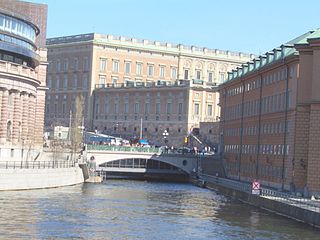
Stallbron is an arch bridge located in Gamla stan, the old town in central Stockholm, Sweden. Stretching some 20 meters over Stallkanalen it connects Riksgatan passing through the Parliament Building on Helgeandsholmen to the square Mynttorget on Stadsholmen from where Västerlånggatan extends it further south.
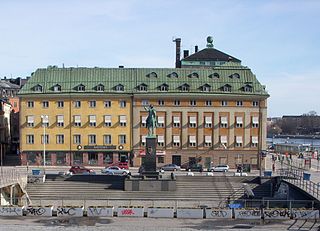
Slussplan is a street in Stockholm, Sweden. Located on the southern end of Gamla stan, the old town, and just north of Slussen and the public square Karl Johans Torg, it stretches west from Skeppsbron to Katarinavägen and Munkbroleden. South of the street is the statue of Charles XIV John, the creation of Bengt Erland Fogelberg and inaugurated in 1854. Järntorgsgatan leads north to the square Järntorget.

The following is a timeline of the history of the city of Stockholm, Sweden.
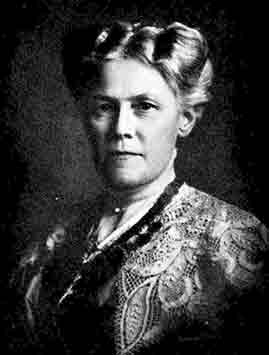
Anna Margareta "Ann-Margret" Holmgren,, was a Swedish author, feminist, suffragist, and pacifist.

Olaus or Olof Verelius was a Swedish scholar of Northern antiquities who published the first edition of a saga and the first Old Norse-Swedish dictionary and is held to have been the founder of the Hyperborean School which led to Gothicism.
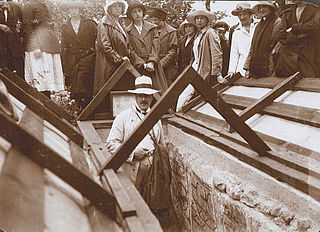
Carl Wilhelm von Sydow was a Swedish folklore scholar. A professor at Lund University, he was a pioneer of folklore studies in Sweden and contributed to establishing systematic methods in the field.

Franciscus Pahr was an Italian architect who worked in Silesia and Sweden from the 1550s. He is remembered above all for his work in Uppsala where he contributed to the cathedral and castle. He refurbished the Upsala castle completely after the fire of 1572. Pahr was from a family of architects who worked in Germany and Sweden during the later part of 16th century and were instrumental in introducing Renaissance architecture to northern Europe. One of the first projects in this genre in Germany was Pahr's work at Uppsala.

The von Sydow murders, is one of Sweden's most notorious criminal cases, occurred on 7 March 1932 in Stockholm.
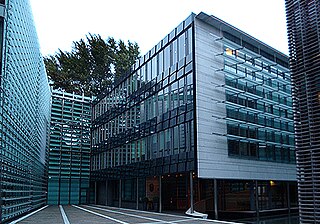
The Embassy of Sweden in Berlin is Sweden's diplomatic mission in Germany. Ambassador since 2017 is Per Thöresson. Sweden established a legation in Berlin in 1912. During World War II, it was destroyed in aerial bombings and the legation was moved to other addresses in Berlin. After the war, the Swedish legation moved to Cologne in West Germany, and in the mid-1950s to Bonn, where it remained until 1999. During the Cold War, Sweden also had an embassy in East Berlin from the 1970s onwards. In 1999, the new Swedish embassy in Berlin was inaugurated and the one in Bonn was closed. The building complex in which the Swedish embassy is located since 1999 is called Nordic Embassies.